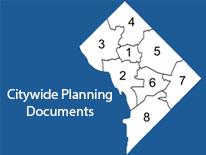
In addition to agency Performance Plans, the District government has several other planning initiatives and projects. Together, these documents help guide District government decision making and long-term planning.
Aging
- Age-Friendly DC Strategic Plan 2023: The District’s second five-year plan to continue implementing World Health Organization-guided changes that make it easier as residents grow older to live, work and play.
- New Community Living Strategic Plan: A comprehensive framework for the DC Office on Aging to address various issues impacting the city’s seniors, persons living with disabilities and caregivers.
Climate & the Environment
- Anacostia 2032 Plan: The District’s plan to make the Anacostia River swimmable and fishable by 2032.
- Climate Ready DC:
- DC Water's Clean Rivers Project: The Clean Rivers Project is DC Water's ongoing program to reduce combined sewer overflows (CSO's) into the District's waterways - the Anacostia and Potomac Rivers and Rock Creek. The Project is a massive infrastructure program designed to capture and clean wastewater during rainfalls before it ever reaches our rivers.
- Sustainable DC: A plan to make the District of Columbia the healthiest, greenest, and most livable city in the United States.
- Sustainable DC Progress Reports: As a part of holding ourselves, our partner agencies, and our city accountable to the goals we have set, Sustainable DC conducts annual progress reports on all of the goals and actions of the plan.
- 2015 Wildlife Action Plan: In order to be eligible for State and Tribal Wildlife Grants, the District is required to have an approved plan in place. Wildlife Action Plans are reviewed and approved by the U.S. Fish and Wildlife Service, and Congress requires states to update their Wildlife Action Plan every 10 years. DOEE updated its Wildlife Action Plan in 2015. The updated plan is based on 10 years of monitoring and data collection. It identifies current needs and priorities to protect the District’s species of greatest conservation need and their habitats. The plan was updated with input from several technical advisory committees, sister agencies, stakeholder organizations and the public.
Education
- Public Education Master Facilities Plan: A long-range strategy that describes how the District can allocate, use and improve school buildings to support high-quality teaching and learning.
- Environmental Literacy Plan: The District’s plan to expand environmental education and awareness in DC public and charter schools.
Equity & Diversity
- 2012 Language Access Report: An analysis of the compliance levels of 32 government agencies designated as having “major public contact,” and therefore bound to additional obligations under the Language Access Act.
- District-wide Bullying Prevention Policy: A guide for creating and implementing bullying prevention policies.
Government Performance
- Agency Performance Plans: A comprehensive list of agency plans that report on metrics and initiatives designed to monitor and improve agency performance.
- Independent Agency Annual Reports: Annual reports are prepared by several boards, commissions, and independent agencies to highlight goals and objectives, accomplishments, and overall performance.
Health & Wellness
- Healthy By Design: A citywide initiative aimed at developing a healthier, more livable, more walkable city.
Homelessness
- 2014 - 2015 Winter Plan: Describes how the District will provide hypothermia shelter and other services.
- DC General Family Shelter Replacement Plan: A plan to replace the number of units currently provided at the DC General Family Shelter in other, more appropriate facilities.
Housing
- Bridges to Opportunity: A New Housing Strategy for D.C.: A plan to create and retain more affordable housing throughout the city.
Jobs & the Economy
- Five-Year Economic Development Strategy: DC’s 2023-2027 economic development strategy focuses on retaining and growing DC’s tax base, supporting business vitality, strengthening neighborhoods, and supporting economic mobility of DC residents.
Parks & Recreation
Planning
- 2006 Comprehensive Plan: The overarching general policy document that provides overall guidance for future planning and development of the city.
- Neighborhood Plans: A comprehensive list of neighborhood planning documents organized by Ward.
- 2016 DC Historic Preservation Plan: A vision for the city's historic environment, partnership opportunities, and goals and targets for action.
Transportation
- moveDC: A plan to develop a bold and implementation-focused vision for the District’s transportation future. MoveDC will incorporate and/or replace stand alone "modal" master plans including:
- Bicycle Priority Network: The Bicycle Priority Network includes streets that have bicycle facilities today and streets that are proposed to have them in the future. The network includes the bicycle priority routes from DDOT’s prior long-range planning work, plus more recent planning efforts to identify gaps and expand access. DDOT’s vision is a Districtwide network of connected bicycle routes that serve all residential areas, providing low-stress routes that are safe, comfortable, and inviting for all bicyclists, from children to seniors. Resources on this page inclue the Bikeway Selection Guide, Urban Bikeway Design Guide, Bicycke Master Plan, and Bicycle Lane Program.
- Pedestrian Program: Walking has been a fundamental part of everyday travel in Washington, DC from the City’s initial design by Pierre L’Enfant in 1791. L’Enfant’s plan for the City was inherently walkable. He envisioned a series of grand avenues radiating from the core of the City, and a grid street network that would overlay these avenues and conform to the contours of the land. Over 200 years later, L’Enfant’s layout of the City remains largely intact and provides both opportunities and challenges to modern pedestrian travel. While some parts of Washington, DC are known throughout the world for being great places to walk because of the grid network and tree-lined streets, others are not. Many of the grand avenues have become major arterial roadways, carrying heavy volumes of traffic and presenting challenges to pedestrians. Resources on this page include the Pedestrian Master Plan 2009 and pedestrian safety corridor projects.
- Public Realm Design Manual: A comprehensive overview of the policies, standards, and regulations that shapes the District's public space in a way that is pedestrian friendly and environmentally responsible.

